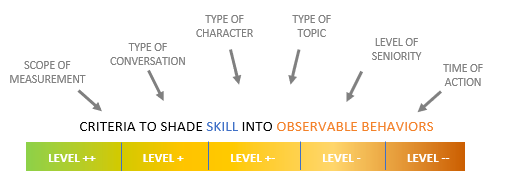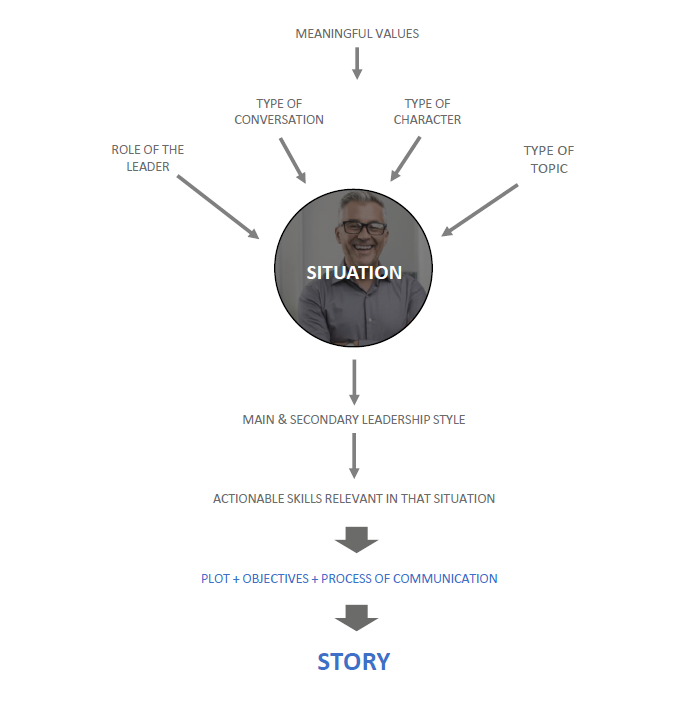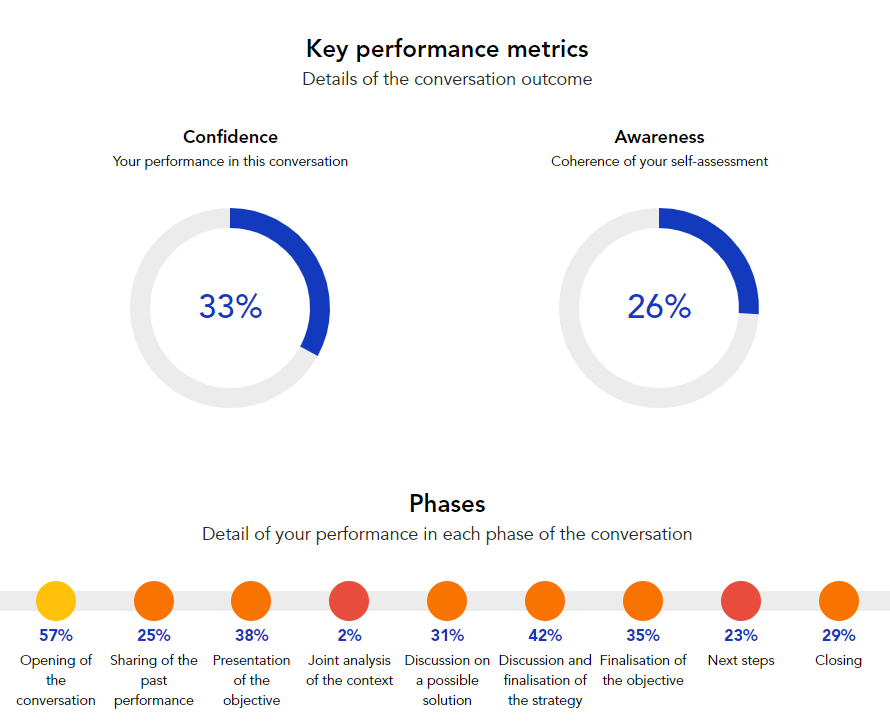
Digital Role Plays are gaining in importance in the training market.
Their benefits include an increase in performance, better user’s involvement, and the fact that you can train where, when and as many times as you want, make them increasingly popular among both trainers and trainees.
But in order to create an efficient role play, a very precise and articulated process has to be followed.
What’s behind a Digital Role Play and how is it designed? How is a training tool for conversational leadership generated? How can we make a role plays consistent?
These are some questions that this article is going to answer.
How to create a simulation: the basics
Before even starting to think about writing the scenario of a simulation, you have to think of the basics, the pillars that define the core of the simulation.
There are four: the purpose of the conversation, the topic, the user’s role and the character.
- Let’s start with the purpose of the simulation, basically what is this simulation for? What’s its goal? Training the Leaders of course, but on what? In other words, you need to define the type of critical conversation you are going to design.
After extensive research, we chose to work on four big types of critical conversations that we called Inspire, Lead, Support and Discover.
To give some concrete examples, the Leader can try to inspire his teams, discover needs or topics to make better decisions, lead people to make things happen or support his team in managing their daily work.
- For the second pillar, you need to define the topic: the topic is basically the framework in which the simulation is based. Just as the type of conversation defines the macro area, the topic is more precise, more “concrete” and closer to the Leader’s activities.
Let’s think a bit about what the greatest topics a Leader has to deal with in his day-to-day-job. For example, it can be teamwork, performance, strategy or diversity.
There are numerous topics you can list and order according to different criteria (subjective vs objective, review vs plan, etc.).
- Once you’ve defined all the topics that you consider relevant to the Leaders, it is time to go define the third pillar of your simulation: the role of the user.
Who will use this simulation? Who do you want to train among your Leaders? We can give a few examples: it can be a Sales Manager, a Project Leader, an HR Manager, etc.
The Leader can be junior or senior, front end or back office. The important point is to define it at the very beginning because the simulation you will design will be different according to its target.
- Finally, you have to define the character the Leader is going to face in the conversation. Not only his role in the team the Leader is managing, but also his personality, his way of thinking and seeing things, his reactions, his needs, etc.
All of these elements will make the characters more realistic, more “human” and above all, more authentic.
Here at SkillGym, we based our research on famous and renowned models like the HBTI® model, the DISC® or Maslow’s hierarchy of needs in order to define the type of characters the Leader is going to meet.
For example, it can be a Dynamic character, who is action-oriented and focuses on results, or a Diplomat, who will be tactful and empathetic, but conservative and reluctant to get outside of his comfort zone.
This means that for example, you can work on the design of a simulation:
- For a Junior Leader (back office)
- Who will try to support one of his team members
- A Diplomat reluctant to change
- On a performance issue
Or a simulation:
- For a Senior Leader (front end)
- Who will try to inspire two team members
- Skeptical characters, who are neither flexible nor empathetic
- On strategy issues
And with these 4 pillars, you have solid ground upon which to build the SITUATION of the simulation.
Before even starting to think about writing the scenario of a simulation, you have to think of the base, the pillars that define the core of the simulation. There are four: the topic, the character, the purpose of the conversation and the user’s role.
How to manage the situation: the styles of leadership
Once you have defined a situation, you obviously have to think about a good way to handle it. In other words, you have to define the best leadership style to manage this particular situation.
Just as you have to adapt your speech and behavior to the person you are meeting, you have to adapt your leadership style to the context you are facing.
For example, you will not use the same style to give negative feedback to an employee or to support one of your team member in prioritizing his tasks, when you’re aligning your teams on the new company’s strategy or when you are exploring a D&I problem.
That’s why our simulations use various styles in their scenarios in order to help the Leader find the best approach with his counterparts. In our curriculum, we work on the basis of 6 styles: Commanding, Visionary, Affiliative, Coaching, Pacesetting and Democratic, as defined by the psychologist Kurt Lewin.
In the previous examples, according to the leadership styles defined, you will use the Visionary style to align your team on the strategy, the Affiliative one for the D&I problem, you will help set priorities with the Democratic style, and so on.
I suggest you take a look at our article “Using Situational Leadership to Manage Different Types of Conversations”, which covers this topic in greater detail.
Defining the skills to train
The next step in the design of a role play is the definition of the actionable skills that you want your Leaders to train on.
There are many skills that a good Leader must have to perform his best on tasks.
You can see the skills of a Leader in his observable behaviors, and SkillGym conducted extensive research to define which ones are fundamental and need to be trained in critical conversations.
There are different categories of skills, for example communication skills that can be broken down into observable behaviors like “ask questions”, “provide information”, “find a common ground”, etc.; or motivation skills with behaviors such as “be inspiring” or “give credit and award”.
You can, of course, rank them according to the type of conversation the Leader is going to face, whether he is trying to inspire his teams, leading them by guiding them in the right direction or discovering issues to improve performance.
In a simulation, the actionable skills you are going to use depend on the styles of leadership that you will be using on this particular situation. It can be, for example, “be authoritative”, “communicate efficiently” and “remove obstacles” for a Commanding leadership style. Or “be inspiring”, “profile other people” or “generate a positive mood” in an Affiliative style.
To go deeper into this topic, you can find more information in our article “Making Competency Models Truly Actionable in People’s Development”.
The skill and its “shading” (in other words, how it is used, from an optimal way to the worst way possible) into observable behaviors is going to vary according to:
- The character: according to his personality, you will not use the skill the same way.
- The role of the Leader: the shading of the skill will be different according to the seniority of the Leader who is playing. Some skills are much more developed for an experienced Leader and the shading will be harder for a senior than for a junior, for example.
- The type of conversation: some skills will be used and shaded differently if you are trying to inspire people or to support them.
- The topic: of course, you will use your skills and behave differently if you’re meeting someone to give him feedback or to define his new priorities with him.
- The moment of the conversation: the “optimal” shading of a skill can change during the conversation. Let’s use a very simple example: when you’re defining what your counterpart’s needs, the optimal skill will be the use of open questions. On the other hand, when you’re summarizing his needs, the optimal way will be to use closed questions.

There are many skills that a good Leader must have to optimally perform his tasks. You can see the skills of a Leader in his observable behaviors, and SkillGym conducted extensive research to define which ones are fundamental and need to be trained in critical conversations.
Adding a plot to the situation
Let’s summarize what we have done so far:
- The first step is to define the four pillars of the role play by thinking about the purpose of the simulation: the type of conversation, the topic to be addressed, the target of the simulation (the role of the user) and the character that the user is going to meet.
- Once you have determined the 4 pillars, and thus the situation, you focus on determining what style of leadership you are going to use to best manage this situation.
- After this step, you need to work on the actionable skills to put into practice during the role play and their shading in observable behaviors.
Once all these elements are clearly defined, you can focus on the plot. This step consists of going into the storyline more in detail to describe precisely the problem the Leader is going to face, the character he is meeting (name, age, background, situational needs, body language, etc.), who asked for the meeting (the Leader or the character), where the conversation is going to take place and when, the context of the situation, etc.
It is also time to settle the expected outcomes of the conversation, in other words the objectives that the Leaders have to reach. It can be for example: define the character’s problem, boost his confidence, raise his awareness about a critical situation, etc.
It’s around these objectives that you will build the whole communication strategy and process, in other words the different steps that the Leader will have to go through to reach these objectives.
To give you a few examples, these steps can be the Analysis of the problem, Sharing of a scalable solution, Definition of the next milestones, etc.
Of course, the communication process depends entirely of the objectives, the style of leadership and the plot in general.
But all of these elements will ultimately help you define the story, as you can see in the schematic below.

Thanks to this structured and extensive process, you have all the cards in your hands to design a powerful and efficient training tool like SkillGym, which also allows you to provide the user with both emotional and contextualized feedback as well as objective metrics.
The feedback can be, for example, the character telling a colleague what he really thought of the meeting you just had.

The metrics can be scores and data on your objective performance during the conversation.

Doing this makes the user use both sides of his brain, the analytical one and the holistic one.
Our research showed us that using both sides of the brain is critical in order to raise users’ self-awareness and thus to help them improve their skills and performance.
For more info on the power of feedback and metrics, I suggest this article (“Why Stimulate Self-Awareness by Using Both Sides of Your Brain?”).
Conclusion
The creation of a Digital Role Play is not just about writing a script that the user must master in order to improve his conversational leadership.
On the contrary, it is a complex and exhaustive process with different steps to follow; the story being only the tip of the iceberg. Everything has to be taken into account (who, what, when, where, why) in order to create a very powerful and efficient tool.
And thanks to its research and experience, SkillGym masters the creation of critical conversations masterfully.
If you want to know more about the metrics to ensure successful training on critical conversations? You may find this article (“8 Key Metrics to Ensure a Successful Practical Training on Critical Conversations”) interesting.
Interested in our approach in building leadership conversation? Please explore the subject more in-depth with our articles “Practicing Conversational Leadership: six factors to consider in designing a well-balanced Training Program” and “Digital Role Play Stripped Bare”.
If you are interested in knowing more about SkillGym and its Digital Role Plays, click here to book a 1-hour discovery call.

